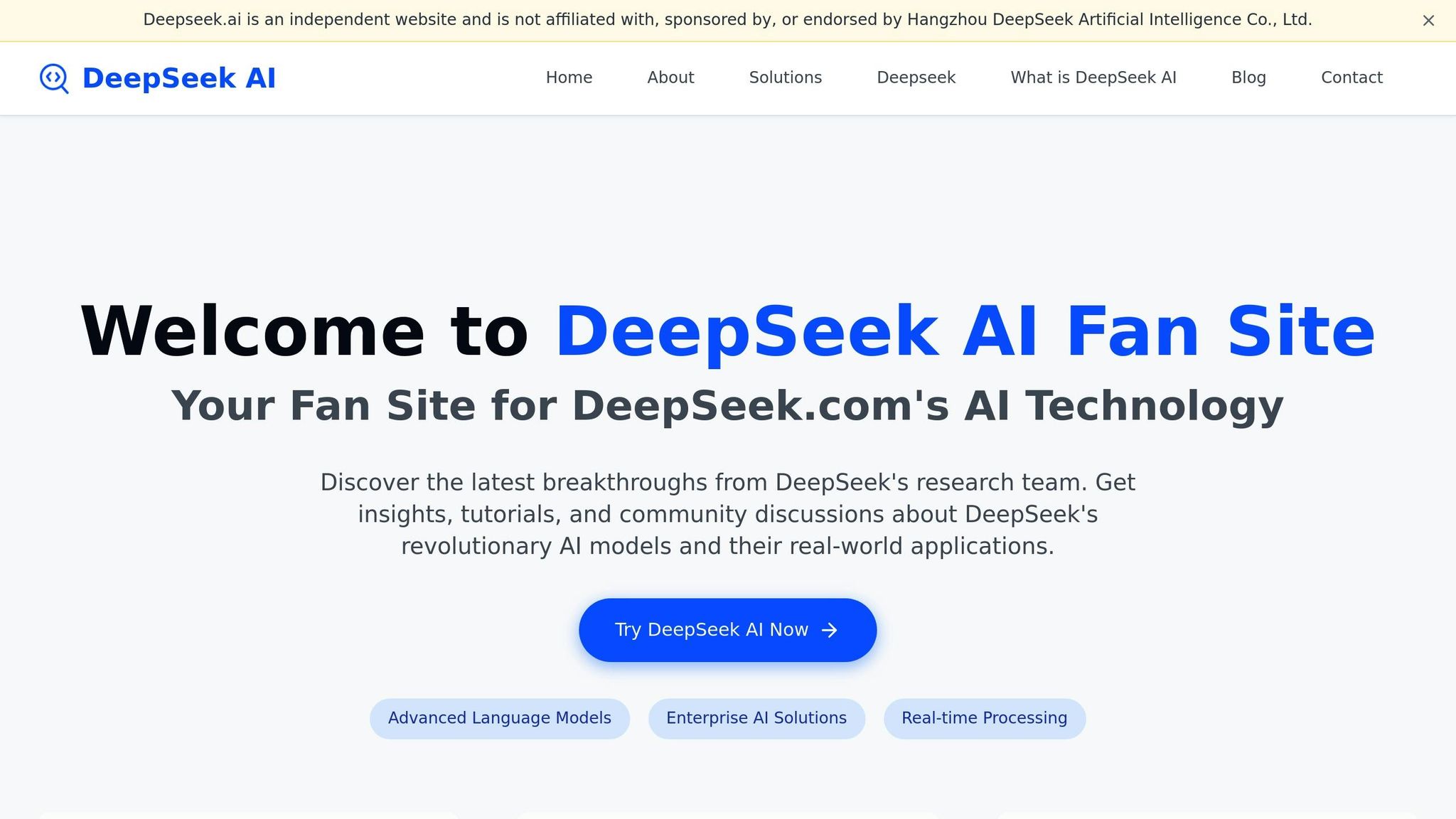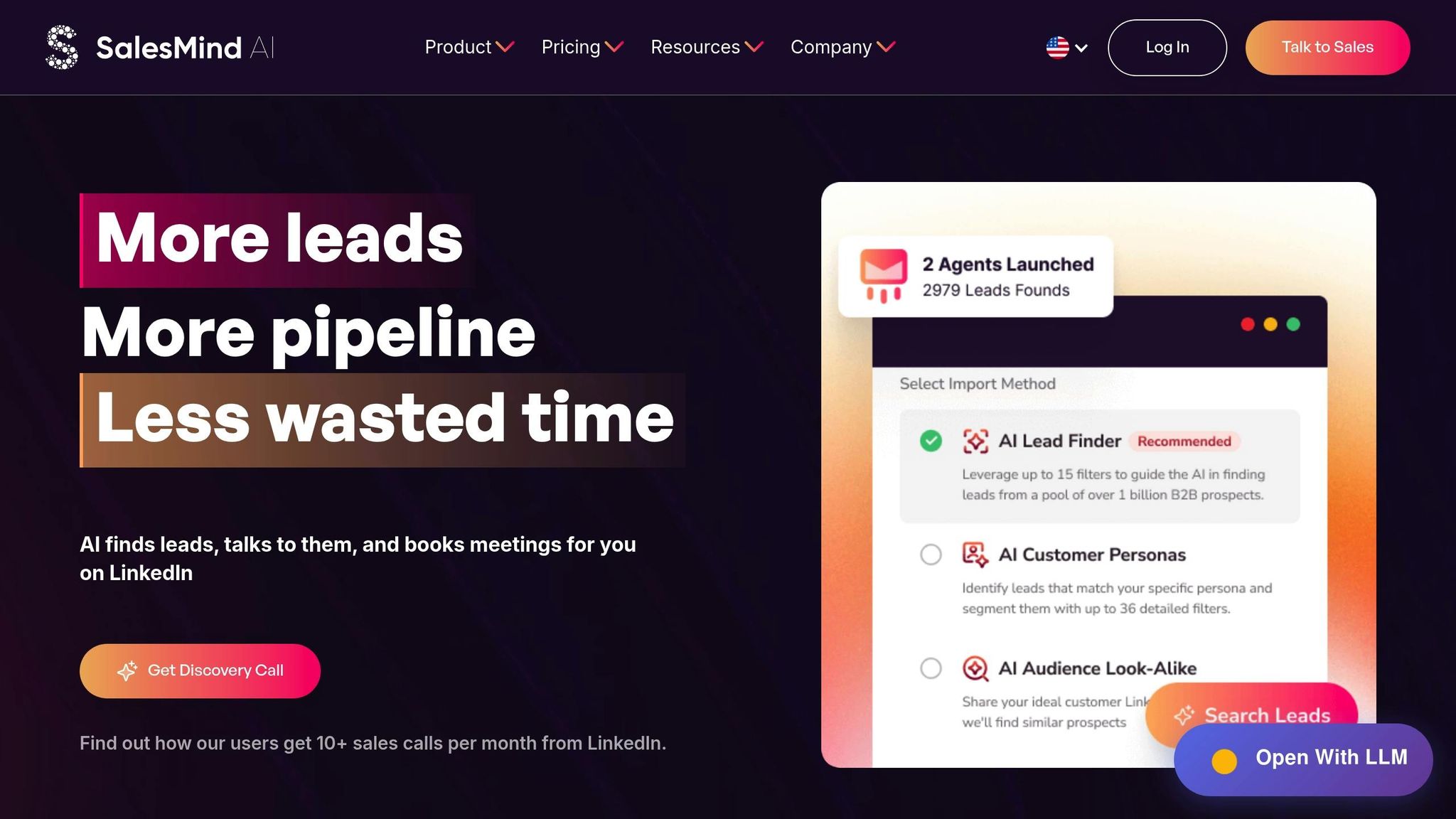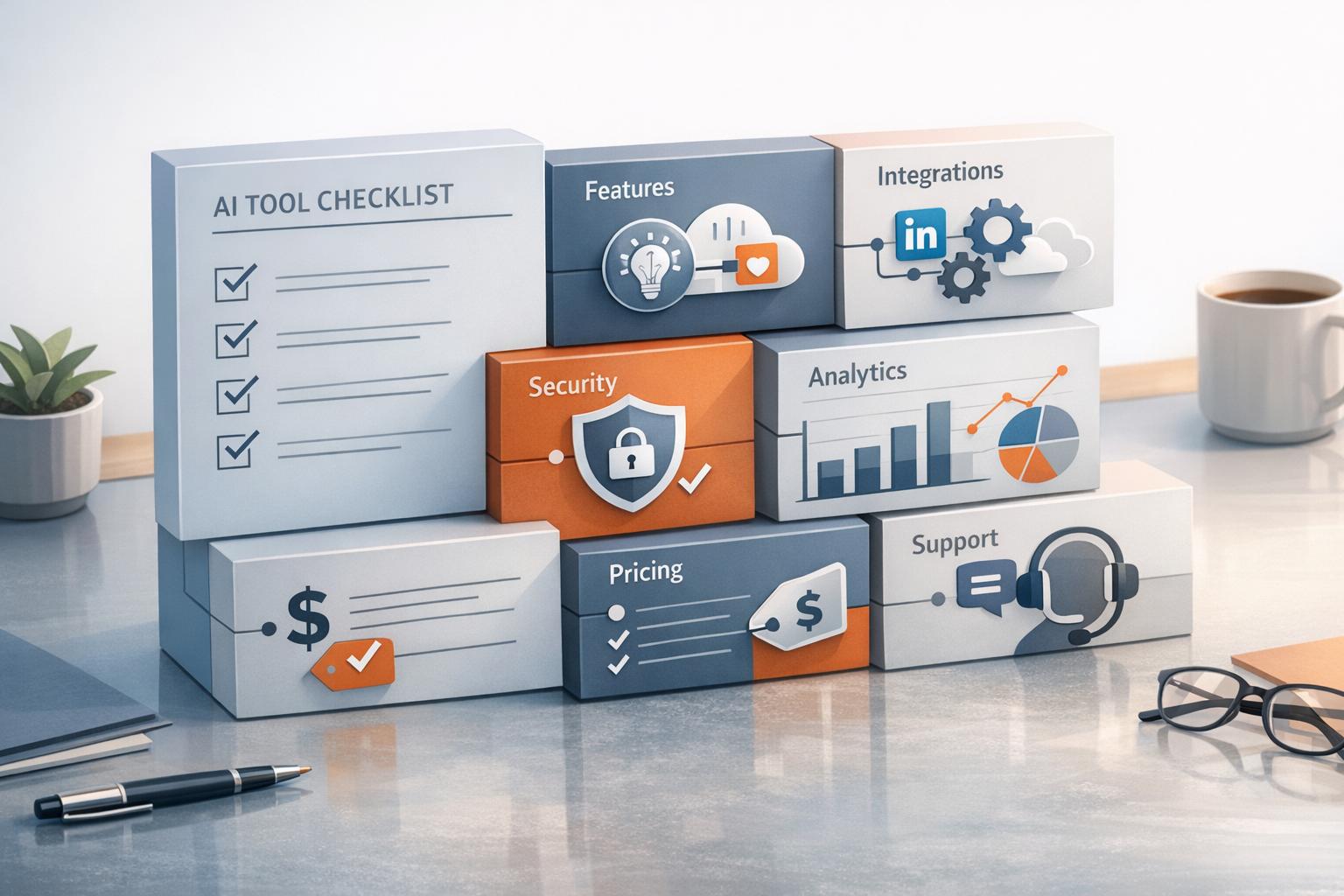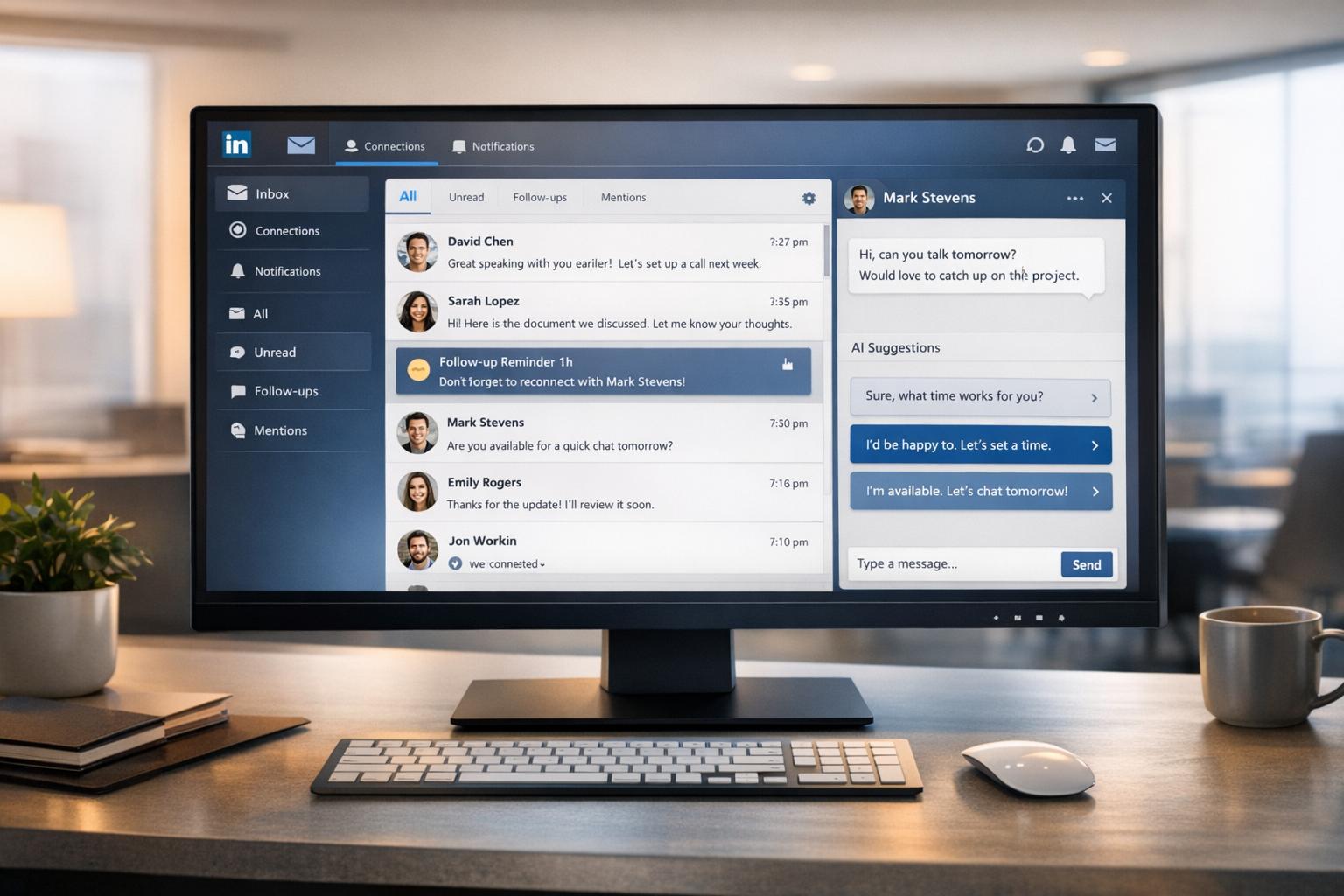
Predictive analytics transforms LinkedIn outreach by using data patterns and machine learning to target the right prospects at the right time. Instead of sending generic messages, it identifies high-value leads, predicts engagement likelihood, and personalizes communication at scale. This approach improves response rates, saves time, and boosts ROI.
Key Takeaways:
- Better Targeting: Focus on prospects most likely to convert based on job changes, company growth, and behavior.
- Improved Timing: Analyze engagement trends to reach prospects when they’re most receptive.
- Scalable Personalization: Use AI to craft tailored messages for hundreds of prospects without losing quality.
- Higher ROI: Companies report up to a 40% increase in campaign ROI and response rates climbing from 8% to 27%.
By integrating tools like SalesMind AI, businesses can streamline outreach, automate follow-ups, and sync data across platforms for a more effective LinkedIn strategy. Predictive analytics isn’t just changing how outreach is done - it’s making it smarter and more efficient.
How I Use DeepSeek AI to Get Clients with LinkedIn Outreach [100% Automated]

Building the Foundation for Predictive Analytics
To get predictive analytics right for LinkedIn outreach, you need to start with a solid foundation. Without well-organized and properly managed data, even the most advanced algorithms won’t deliver the results you’re aiming for. A strong groundwork ensures your predictions remain reliable and actionable.
Companies that focus on proper data management and governance achieve far better outcomes from their predictive analytics. It’s not just about collecting more data - it’s about gathering the right data, organizing it effectively, and maintaining its quality over time.
Data Collection and Integration
Creating accurate predictive models hinges on pulling together data from multiple sources to form a full view of your prospects. Data integration brings together information from LinkedIn, CRM systems, email platforms, and website analytics into a single, centralized hub.
For instance, LinkedIn provides valuable insights like job updates, professional activity, and engagement metrics. When combined with CRM records and website analytics, this data paints a detailed picture of your prospects. Such integration enables predictive models to work smarter, not harder.
Here’s an example: A B2B SaaS company combined LinkedIn data, CRM information, and website analytics. This allowed them to use AI-driven personalization, which boosted response rates from 8% to 27% and reduced qualification time by 60% [2].
Data enrichment tools can further enhance this process by filling in gaps with updated company news or personnel changes - data points that often signal buying intent. Modern platforms also simplify this process through automated, API-driven syncing, ensuring all relevant data flows seamlessly into your system without the need for manual updates.
Platforms like SalesMind AI take this a step further by integrating LinkedIn outreach automation with built-in data syncing. SalesMind AI automatically gathers insights from LinkedIn profiles and combines them with your existing data to create detailed prospect profiles, ready for predictive analysis.
Once your data is consolidated, the next critical step is ensuring its accuracy and reliability.
Data Accuracy and Governance
Bad data leads to bad predictions - it’s that simple. If your predictive models are trained on flawed or outdated information, they’ll generate unreliable outcomes, which can derail your outreach efforts.
Establishing strong data governance protocols is key. This involves setting clear rules for how data is collected, stored, and used across your organization. It also means ensuring compliance with privacy regulations like GDPR and CCPA, implementing access controls, and conducting regular audits to maintain data quality. Privacy compliance requires secure storage, transparency in collection methods, and strict adherence to legal standards.
A robust governance framework includes policies for data collection, storage, usage, and maintenance. Automated checks can help catch issues early by flagging missing fields, spotting duplicate entries, and validating formats before they disrupt your predictive models.
Collaboration across departments is equally important. Sales teams can provide feedback on lead quality, marketing teams can share campaign performance data, and customer success teams can highlight what drives conversions. This kind of cross-team effort ensures that your predictive models align with real-world insights.
The payoff for investing in a strong data foundation is clear. Companies with well-governed data see more accurate predictions, improved targeting, and higher conversion rates. It’s the difference between making educated guesses and knowing exactly which prospects deserve your attention.
Using Predictive Analytics Tools for LinkedIn Outreach
Once you've built a solid foundation of data, the next step is selecting tools that can turn that information into actionable outreach strategies. The right predictive analytics platform can mean the difference between scattershot efforts that miss the mark and focused campaigns that deliver real results. These tools take your data and transform it into targeted, impactful outreach.
Predictive analytics tools go beyond basic automation. They use AI to analyze prospect behaviors, predict engagement likelihood, and adjust your approach in real time. It's this shift - from manual guesswork to data-driven precision - that sets successful LinkedIn campaigns apart from those that fail to gain traction.
Key Features of Predictive Analytics Platforms
Advanced lead scoring is a cornerstone of effective predictive analytics tools. These platforms analyze a wide range of data points - like LinkedIn activity trends and company growth metrics - to assign each prospect a likelihood-to-convert score. By focusing your efforts on the most promising leads, you can save time and improve results.
AI-driven personalization takes targeting to a new level by creating tailored messages for each prospect. Using profile data, recent activity, and behavioral patterns, the system generates outreach that feels relevant and specific. For example, it might consider job changes, company updates, or engagement history to craft messages that don’t feel like generic templates.
Real-time performance tracking and automated follow-ups ensure campaigns remain effective as they progress. These tools help identify which message variations work best and determine the ideal timing for outreach. Automated follow-ups, triggered by actions like profile views or content engagement, ensure prospects don’t slip through the cracks.
Multi-channel coordination further amplifies your efforts by synchronizing outreach across various platforms, while predicting which engagement channel will yield the best results.
These features make it easier to scale your efforts while maintaining quality. AI-powered personalization, in particular, allows businesses to reach more prospects without sacrificing the human touch, leading to higher response rates and better outcomes [2].
Streamlining Outreach with SalesMind AI

SalesMind AI takes these advanced features and turns them into a streamlined, high-performing outreach system. By combining powerful lead scoring with AI-driven messaging, the platform helps businesses engage with prospects at scale while keeping interactions personalized.
The AI-powered unified inbox serves as a central hub for managing all LinkedIn conversations, even across multiple accounts. Instead of juggling different interfaces, users can rely on a single dashboard enhanced with AI tools that suggest responses, tag conversations, and set reminders automatically.
Advanced lead qualification uses predictive algorithms to pinpoint the leads most likely to convert. This means sales teams can focus their energy on high-potential prospects rather than wasting time on less promising ones. By analyzing profile details, engagement patterns, and behavioral signals, the system highlights opportunities that deserve immediate attention.
With seamless CRM integration, all interactions and insights flow directly into your existing sales systems. This eliminates data silos and ensures you have a complete view of each prospect's journey, from the first LinkedIn connection to closing the deal.
The platform's automated follow-up capabilities handle repetitive outreach tasks while preserving the personal touch LinkedIn users expect. You can set up sequences that adapt based on a prospect’s responses or behavior, keeping engagement consistent without requiring constant manual input.
Real user feedback underscores the platform’s impact. For instance, Sébastien D., a freelance professional, shared:
"Amazing tool that allowed me to save so much time on my LinkedIn outreach. But that's not all, by automating all conversations and personalizing them with direct insights extracted from my prospect profiles, it gives accurate and high-quality outputs that helped me get more prospect meetings and thus close more deals! It's definitely a game changer, thanks for this great tool!" – Sébastien D., Freelance, Freelance Insider [1]
Steven Huibers, COO of Policereports.ai, added:
"I've used a couple of other tools for LinkedIn outbound, but this has gotten me 3x the results." – Steven Huibers, COO, Policereports.ai [1]
The results speak for themselves. Users report an average 40% acceptance rate and 45% reply rate, with an average pipeline value of $100,000 per month [1]. These metrics illustrate how predictive analytics tools like SalesMind AI can transform LinkedIn outreach from a volume-based approach into a precision-driven strategy.
Additionally, campaign optimization features help refine your outreach further. By analyzing campaign performance, the system provides insights to improve messaging, enhance your LinkedIn profile, and increase lead acquisition rates. Over time, the platform learns and adapts, automatically implementing changes that drive better engagement and conversion rates.
sbb-itb-817c6a5
Improving LinkedIn Outreach with Predictive Insights
Once you've set up your predictive analytics tools, the real challenge begins: using the insights they provide to fine-tune and elevate your LinkedIn outreach. What separates a decent campaign from an outstanding one is how effectively you use data to make ongoing improvements. This process isn’t static - it’s dynamic and builds on the strong data foundation and tools you’ve already put in place. Instead of relying on guesswork, you can use real-time feedback to continuously optimize your campaigns. These insights allow you to sharpen both your strategy and the precision of your messaging.
It’s important to remember that predictive analytics isn’t a “set it and forget it” solution. It’s an ongoing cycle of testing, analyzing, and adjusting based on what the data tells you about your prospects’ behavior and preferences.
Using Predictive Analytics for Campaign Improvement
Real-time monitoring is a game-changer for campaign performance. Instead of waiting weeks for results, you can track key metrics as they happen. This immediate feedback helps you identify trends and make quick adjustments to your strategy.
Timing is another area where predictive analytics shines. By analyzing data, you can pinpoint when your audience is most active on LinkedIn. For instance, if financial services professionals tend to respond more on Tuesday mornings, you can schedule your outreach to align with their activity patterns.
A/B testing with predictive analytics takes the guesswork out of campaign optimization. You can systematically test different elements - subject lines, message lengths, call-to-action phrases, or follow-up timing - and let the data guide your decisions. These systems don’t just evaluate options; they identify the most effective variations and apply them to similar audience segments, all while continuing to experiment with new strategies.
Data-driven adjustments ensure your campaigns evolve based on real performance rather than assumptions. This might mean refining your ideal customer profile as you discover which prospects are converting, tweaking messaging based on response patterns, or optimizing follow-up sequences using engagement data.
Many businesses have seen measurable improvements in their outreach by leveraging predictive insights [2].
Measuring and Improving Engagement
Once you’ve implemented these optimization strategies, accurately measuring engagement becomes essential. Tracking the right engagement metrics is key to understanding how well your campaigns are performing and identifying areas for improvement. While basic metrics form the foundation, predictive analytics can go further by monitoring more nuanced behavioral signals - like profile views after a message is sent, engagement with shared content, or the amount of time prospects spend exploring your company’s information. These signals often provide a clearer picture of conversion potential than traditional metrics alone.
Lead qualification rates are another critical measure of success. Generating responses is great, but what really matters is whether those responses come from prospects who have genuine interest and decision-making authority. Predictive analytics helps identify these high-value leads by analyzing factors like company growth trends, recent funding, leadership changes, and technology adoption.
The benefits of focusing on engagement quality are clear. For example, users of SalesMind AI report an average connection acceptance rate of 40% and a reply rate of 45%, with an average pipeline value of $100,000 per month [1].
Refining your messaging based on engagement data ensures your outreach stays effective as market conditions and audience preferences shift. This could involve analyzing message tone, incorporating industry-specific language, or adapting to seasonal trends.
Predictive analytics doesn’t stop there - it can also refine the timing and frequency of your follow-ups. By studying response patterns, the system can suggest the best intervals for follow-ups and identify when prospects are most likely to engage.
The most successful campaigns create a feedback loop where every interaction generates data to refine future outreach. This might involve updating prospect scoring based on conversion data, improving personalization algorithms based on response trends, or adjusting targeting criteria to focus on the most promising prospects.
Research shows that 97% of marketers using predictive analytics report better campaign performance and engagement. Additionally, LinkedIn account-based marketing powered by predictive analytics can boost ROI by 35–40% through improved targeting and smarter resource allocation [4].
Best Practices for Long-Term Predictive Outreach Success
Creating a lasting and effective predictive analytics strategy requires more than just a good start - it demands consistent effort, strategic growth, and teamwork. The most successful organizations know that keeping predictive analytics effective means regular updates, thoughtful scaling, and collaboration across teams. Building on the principles of strong data management and advanced analytics tools, here are some key practices to ensure your outreach continues to deliver results over time.
Regularly Updating Predictive Models
Predictive models are only as reliable as the data they’re based on. And let’s face it - data ages fast. Customer behaviors change, market conditions shift, and platforms like LinkedIn frequently update their algorithms. If your models aren’t refreshed with current data, you risk losing accuracy, which can lead to missed opportunities or wasted efforts on low-potential leads [3].
For example, a model trained on last year’s data might miss how remote work has altered when B2B decision-makers are active on LinkedIn. This could mean your outreach is mistimed, leading to lower response rates and reduced ROI. To avoid this, schedule regular model reviews - quarterly at a minimum. However, major changes, like a drop in engagement rates, significant market shifts, or updates to LinkedIn’s features, should trigger immediate updates.
Keeping your data clean and organized is just as important. Consolidate information from all relevant sources - your CRM, LinkedIn analytics, email platforms, and website data - and regularly remove duplicates or outdated entries. Tools like SalesMind AI can automate much of this process, continuously updating your data and keeping your models accurate without requiring constant manual effort.
Starting Small and Scaling Up
It’s tempting to roll out predictive analytics across your entire LinkedIn outreach operation right away, but starting small is usually the smarter move. Begin with a focused pilot, targeting a specific group - like a single industry or job function - and track metrics such as open rates, response rates, and lead quality. This approach allows you to fine-tune your models and strategies based on real-world performance before committing more resources.
Pilot programs often reveal valuable insights, leading to noticeable improvements in engagement and lead qualification. Once you’ve tested and refined your approach, you can expand to other segments, industries, or regions, scaling your outreach while maintaining quality.
Choose test segments that are large enough to provide meaningful results but small enough to limit risk. Once you’ve validated your approach, you can confidently grow your efforts, knowing your strategy is backed by data.
Working Across Teams
Predictive analytics becomes far more powerful when it’s a shared effort among teams. Sales, marketing, and analytics departments each bring unique strengths to the table, and when they collaborate effectively, the results can be transformative. This teamwork ensures that predictive insights translate into actionable strategies aligned with broader business goals [3].
- Sales teams can provide feedback on lead quality and highlight patterns that may not be immediately obvious from the data.
- Marketing teams contribute by refining messaging and personalization strategies based on engagement data.
- Analytics teams focus on keeping models accurate and uncovering new areas for optimization.
That said, collaboration isn’t always easy. Misaligned goals, data silos, and poor communication can slow progress. To overcome these challenges, set shared objectives, hold regular cross-functional meetings, and use integrated data platforms so everyone has access to the same insights.
"Not long started, however, the platform seems really intuitive, and I know different areas of our business have had success with this platform already. We're at the start of our plans with SalesMind AI, and we're hoping for this to be a long-term relationship with great results."
This quote highlights how predictive analytics platforms can break down silos, fostering shared learning and coordinated strategies. Leadership also plays a critical role. When executives prioritize collaboration and establish clear accountability, teams are more likely to align their efforts. Regularly sharing insights and results keeps everyone motivated and ensures that every team member sees how their work contributes to overall success.
Vendor partnerships can further amplify these efforts. Experienced providers don’t just supply tools - they offer strategic guidance to help shape your approach.
"They didn't just show me how to use the tool; they actually helped me shape my overall marketing approach too."
When teams work together using predictive insights, the benefits are clear: higher lead-to-customer conversion rates, larger deal sizes, shorter sales cycles, and better customer lifetime value. Over time, this collaboration leads to lasting improvements that extend beyond individual campaigns [3].
Conclusion: The Future of LinkedIn Outreach with Predictive Analytics
LinkedIn outreach is undergoing a major transformation, moving away from generic, broad approaches to strategies driven by data that deliver tangible results. Companies leveraging predictive analytics are seeing response rates soar - from 8% to 27% - and campaign ROI climb by as much as 35–40% [4]. These numbers highlight the impact of using data to refine and enhance LinkedIn outreach efforts.
Take Sarah Chen's 2024 success story, for instance. By integrating predictive analytics into her prospecting process, she achieved a staggering 400% increase in weekly outreach while also boosting response rates and cutting down on administrative tasks. This isn’t about working longer hours - it’s about working smarter by using data to identify the right prospects, the right timing, and the right messaging.
Platforms like SalesMind AI are making this shift accessible to businesses of all sizes. With tools like automated personalized messaging, advanced lead scoring, and an AI-powered unified inbox, companies can now scale their outreach with precision. The platform’s seamless LinkedIn integration ensures these advanced analytics fit smoothly into existing workflows, making it easier for U.S. businesses to adopt and benefit from these advancements.
What’s next for predictive analytics? Real-time performance monitoring is becoming a must-have, allowing businesses to adjust strategies instantly based on live data. Outreach is also expanding beyond LinkedIn to create unified, multi-channel campaigns. Meanwhile, advances in generative AI are opening doors to even more personalized communication, all while staying compliant with privacy regulations.
The companies that succeed in this new landscape share a few key practices: they maintain clean, well-organized data, encourage collaboration between sales, marketing, and analytics teams, and regularly update their models to keep pace with change. These steps ensure a move from short-term wins to long-term success. The real advantage lies not just in having cutting-edge technology but in using it strategically to build authentic, high-value connections.
For U.S. businesses looking to surpass the limits of traditional outreach, predictive analytics offers a clear way forward. It’s no longer a question of whether to adopt this technology - it's about how quickly you can integrate it to stay competitive in a fast-changing market.
FAQs
How does predictive analytics help personalize LinkedIn outreach without sacrificing quality?
Predictive analytics takes LinkedIn outreach to the next level by diving deep into data to pinpoint high-value prospects and customize messages that align with their interests and needs. By tapping into insights like industry trends, past engagement, and behavioral patterns, businesses can create messages that feel personal and relevant to their audience.
This strategy doesn’t just boost the odds of building meaningful connections - it also raises the quality of interactions. Instead of sending out generic or overly automated messages, it focuses on delivering value to each prospect, making every interaction count.
What are the best practices for managing data to optimize predictive analytics in LinkedIn outreach?
Effective data management lays the groundwork for using predictive analytics effectively in LinkedIn outreach. Start by keeping your data clean, current, and relevant. Regularly review and update your datasets to eliminate duplicates, outdated records, or incomplete entries that might distort your predictions.
Organizing your data is just as important. Group information into clear categories like industry, job titles, or engagement history. This structure helps predictive models spot trends and zero in on high-value prospects. Tools like SalesMind AI can make a big difference here, offering features to integrate data seamlessly and automate lead scoring. With these tools, you can craft personalized outreach messages based on actionable insights.
When your data is clean, structured, and organized, your predictive analytics will yield better results, helping you build stronger, more meaningful connections with your LinkedIn prospects.
How does real-time performance tracking improve LinkedIn outreach campaigns?
Real-time performance tracking lets you gauge how well your LinkedIn outreach campaigns are performing as they happen. By keeping an eye on metrics like response rates, engagement levels, and lead conversions, you can pinpoint what’s hitting the mark and make quick adjustments to improve your approach.
This flexible method keeps your outreach sharp and focused, helping you zero in on valuable prospects while tailoring your messages to resonate more effectively. Tools such as SalesMind AI can make this process even smoother by automating insights and fine-tuning your campaigns for stronger outcomes.


.avif)


